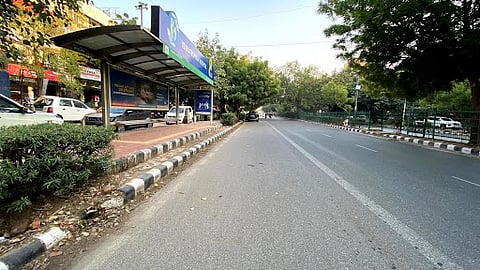If Delhi Transport Corporation doesn’t fix longstanding issues, coming generations won’t ever step foot on its buses
Delhi is ranked as the second worst city in mobility, according to the Union Ministry of Housing and Urban Affair’s Ease of Living Index which also has the least number of buses per 100,000 population amongst all the Tier 1 cities.
Options of public commute for a Delhi citizen, would typically be based on individual choices influenced by the incentives presented to the commuter. In the case of Delhi, the most visible choices would be Delhi Metro, Delhi Transport Corporation (DTC) and ride hailing services such as Uber, Ola, Shuttle and Rapido.
Incentives largely dictate the decision for the commuter and for a metro city like Delhi it would come down to factors such as perception of safety, convenience, duration and cost.
The intricate balance of these factors determines the commuter’s choice, while also considering the socio-economic and behavioural conditions of the decision-maker.
The inconsequential standing of the DTC in the choice ladder, especially when juxtaposed with the Delhi Metro, is not merely because of the exemplary status of the latter which is known for its connectivity and relatively efficient commute time.
Pros and Cons
While it is true that these are clear incentives for one to choose to go for a metro, there are several influential disincentives inherent to the present governance of the DTC public transportation system.
However, with Delhi Metro being the second most unaffordable metro in the world (CSE, 2018), DTC still is the only forced upon choice for many, especially those from socioeconomically weaker sections (Hemant K. Suman et al 2016).
While when it comes to those commuters who can afford to make the choice, DTC unequivocally will be the last. DTC, instead of augmenting the ridership, is witnessing a decline in ridership trend (Delhi Economic Survey 2023-24), and with the subsidised bus fare being the majority of its revenue source (Project Jankari, SRCC 2020-21), the losses would only exasperate towards not just a financial burden which already exceeds Rs 3,700 crores (CAG 2022), but also an impending environmental catastrophe as it loses its public transit share of passengers to private vehicles. Notably vehicular emission is the major contributor of Delhi’s Air Pollution (Anumita Roychowdhury et al, CSE 2024).
In order to curb the menace of urban traffic congestion and the associated air pollution adversity affecting the psychological and physical wellbeing of Delhi citizens, it’s pivotal for the contemporary governance modalities of DTC to be reinvigorated.
Politics of transportation
It’s evident that investing in the DTC’s governance is not an attractive political strategy for our government as investing in big flyovers, highways or DMRC’s rail network would be. Naturally bigger infrastructure is more visible, and will have the tendency to attract voters’ attention, but at a substantially lower cost, investing in DTC’s governance system has the tendency to create a substantial social impact towards improving the urban mobility crisis.
In order to attract ridership, and encourage the shift from private vehicles to public buses, it's paramount to understand the plight of a commuter. The first thing they would do is to plan their trip by finding out the route, bus number, bus stop and time schedule.
The usual way is through Google and the other two options are through One Delhi or Chartr mobile app, both the applications are not optimised beyond locating the ‘nearest stop’, the general experience is confusing and sometimes even misleading.
After this predicament, often the commuter has to traverse through a not so scenic pedestrian walkway towards the bus stop.
There is an over reliance on the word of mouth for knowledge dissemination usually solicited from regular commuters, who generally have empirical knowledge of the bus route, it’s number and estimated wait time (Project Jankari 2020-21).
Without any reliable real-time tracking of buses, the commuter has to often wait for longer durations with unpredictable arrival time with almost all the bus stops having a wait time of more than 10 minutes (Annual State of India's Environment, CSE 2024).
Even after waiting for a long duration, a non-compliant bus driver might fail to stop at the bus stop aggravating the agony of the commuter.
Currently the majority of the DTC staff are contractual, and with no adhering framework for feedback or accountability, there is virtually no repercussion or penalty for noncompliance.
During the commute, there is plausibility of the bus being overcrowded, such situations diminish the sense of safety and security especially for women (Shreya Ganguly, ORF 2024). As the public buses still don’t seem to have a prioritised mobility on public roads, they have become a part of a heavy traffic increasing the travel time of the commuters. Adding to the commuter's plight, RTI reports filed by a news outlet last year indicate that DTC bus breakdowns have increased by 166 per cent over the past year
In conclusion
So, the only benefit/incentive for a rational commuter comes down to the subsidised cost of DTC. However, when the cost of waiting, interchange and time taken in traffic congestion is considered, the total journey cost increases substantially for public transport users, compared to private transport users (CSE, 2024).
Without addressing the problems in pertinent governance structure of the DTC transportation system, policy intervention such as free rides for women, employing bus marshals, online ticketing, electrification of bus fleets, odd-even rule or dedicated bus driving lane — will not have an effectual policy outcome.
Addressing the gaps in the present digital infrastructure system for finding the route, the bus stop, reaching the bus stop, boarding the bus and buying the ticket could be a good start.
The disrepair of DTC buses, if not addressed soon will despair the commuters, and the coming generation with economic prosperity will never set foot in our public buses again.
Views expressed are author's own and do not necessarily reflect that of Down To Earth

